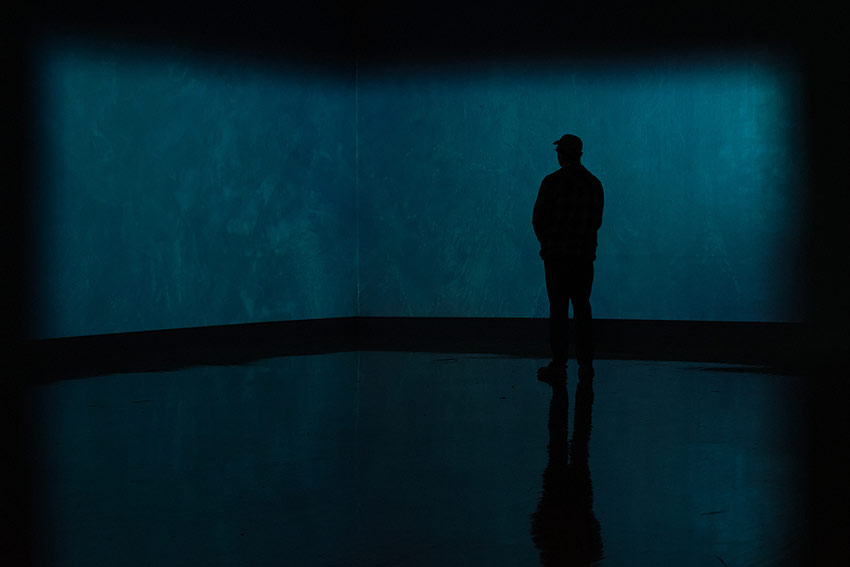Climate crisis artwork on show in India

AUT Associate Professor Janine Randerson (School of Art and Design) and Senior Lecturers Rachel Shearer and Stefan Marks (School of Future Environments) head to India this week to presentthe audiovisual artwork Ngā Raraunga o te Mākū: the data of moisture at KHŌJ, a leading contemporary art centre in New Delhi.
Part of the exhibition 28° North and Parallel Weathers, opening 31 January, the installation visualises data, sounds and images, which are livestreamed to KHŌJ from Haupapa / Tasman Glacier.
Originally commissioned by Auckland contemporary gallery Te Tuhi as part of Te Moana Nui ā Kiwa weather station for the World Weather Network, the artists collaborated with glaciologist Heather Purdie and orator Ron Bull (Waitaha, Kāti Mamoe, Kāi Tahu.)
Since the 1990s, Haupapa / Tasman Glacier, the longest in Aotearoa, has melted at an average rate of 180m each year – almost twice the length of a rugby field. Beginning in the heart of Aoraki Mt Cook National Park, the glacier is fast transforming into a lake more than 240 metres deep that didn’t exist before 1989.
“The accelerating change of state of Haupapa glacier into the grainy liquid expanse of Haupapa awa, the lake below, is a highly visible indicator of climate catastrophe,” the artists say.
“We respond to an urgent tipping point where we face water scarcity in some parts of our isles, and vanishing glaciers, flooding, severe storms and coastal erosion that meets rising seas on the other, as the whenua sinks incrementally back down to our watery origins.”
At the opening event, Dr Shearer (Rongowhakaata, Te Aitanga a Māhaki, Pākehā,) a sound artist and designer, will perform live sound of processed field recordings from Haupapa Glacier and other locations in Aotearoa, presented as a collateral event to the India Art Fair at KHŌJ Studios.
About Haupapa Glacier
In the traditions of the Kāi Tahu people (the principal Māori iwi (tribe) of the South Island of Aotearoa New Zealand) Haupapa is a body of ice formed from a deep exhalation of Aoraki, the ancestor mauka, as he readied to speak. The glacier is now transforming into Aotearoa’s fastest-growing body of wai (water) in the lake below, releasing the ancient breath of those who walked there long ago.
Guiding the group in developing this work, glaciologist Heather Purdie has found that the glacier is melting from within crevasses in the glacier accumulation area that retain the sun’s heat. At the end of Haupapa, there are submerged ice ramps in the lake, which cause large icebergs to split off and accelerate the glacier’s recession.
Kāi Tahu descendant, cross-cultural collaborator and researcher Ron Bull has guided and fuelled the project with an ethos of gifting and offering as the group responded to these transforming elements.
About the artists
Dr Stefan Marks is a creative technologist at AUT’s School of Future Environments. His main areas of research are collaborative extended reality (XR) and data visualisation or, as he prefers to call it, “data-driven, immersive storytelling”. Dr Marks creates tools to turn complex or abstract information into visual, audible and other sensory forms to allow the human brain to perceive, discover and understand patterns and relations. Some of his projects have dealt with earthquake data, the human nasal cavity anatomy, and artificial neural network connectivity.
Dr Janine Randerson is an Associate Professor at the School of Art and Design. The artist, film and video maker and writer often practices in collaboration with environmental scientists and community groups. Dr Randerson’s book Weather as Medium: Toward a Meteorological Art (MIT Press, 2018) focuses on modern and contemporary artworks that engage with our present and future weathers. Dr Randerson also facilitates art exhibitions, events and screening programmes.
Dr Rachel Shearer, of AUT’s School of Future Environments, investigates sound as a medium through a range of sonic practices. These include installations, composition, recording, writing and collaborating as a sound designer or composer for moving image and live performances. Active as an experimental musician releasing audio publications both locally and internationally, Dr Shearer’s work builds on her research, which explores practices related to a listening to the earth through Māori and Western frameworks. She has received numerous public commissions for site-specific sound installations including the permanent nine-channel sound installation The Flooded Mirror at Auckland’s Wynyard Quarter.